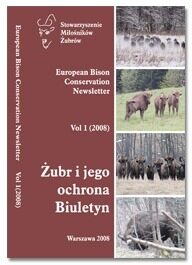Helminthological status of European bison in Białowiez˙a Forest in the winter 2007/2008
Keywords:
Euroepan bisonAbstract
The infection of European bison with the most important parasites like nematodes of abomasum, large intestine and lung, tissue nematodes, flukes of liver and tapeworms in the winter season 2007–2008 in Białowieża Forest is being discussed in this paper. During the last years 100% of adult bison have been infected by blood suckling nematodes of abomasum Ashworthius sidemi and liver flukes Fasciola hepatica. In the last winter season not only maximal, but also mean intensity of A. sidemi invasion decreased in comparison with the former year. It can implicate that after eight years long contact with a new pathogen, the European bison created some immunological mechanisms that limit the number of parasites. The alarming thing is the double rise of a maximal intensity of invasion of F. hepatica which attained 635 specimens. In comparison with the results of the earlier examinations, the helminth fauna of large intestine enriched on two species: A. sidemi and Nematodirus helvetianus. The presence of A. sidemi – the parasites of abomasum and N. helvetianus – parasites of duodenum in a large
intestine are caused by a very high intensity of A. sidemi in the place of a typical localization in abomasum and duodenum, and their dispersion to the other parts of a digestive tract. Extensiveness of invasion in bison with the lung nematodes D. viviparous, that was recorded in present examinations is the highest found ever in bison in Białowiez˙a Forest. The mean intensity of this invasion is three to four times higher than earlier, and the maximal one is tens times higher. Extensiveness of invasion of tissue nematodes Onchocerca lienalis is a little higher, and this one of O. gutturosa has not changed, and the intensity of invasion in both mentioned species is still on this same level. There was a twice as high decrease in extensiveness of invasion of Setaria labiatopapillosa observed. Intensity of this invasion was also much lower. Cestodes from the genus Moniezia were found in 41% of examined bison. Bison of all age groups were infected by those parasites.
Downloads
Published
How to Cite
Issue
Section
Categories
License
Copyright (c) 2008 European Bison Connservation Newsletter

This work is licensed under a Creative Commons Attribution 4.0 International License.





